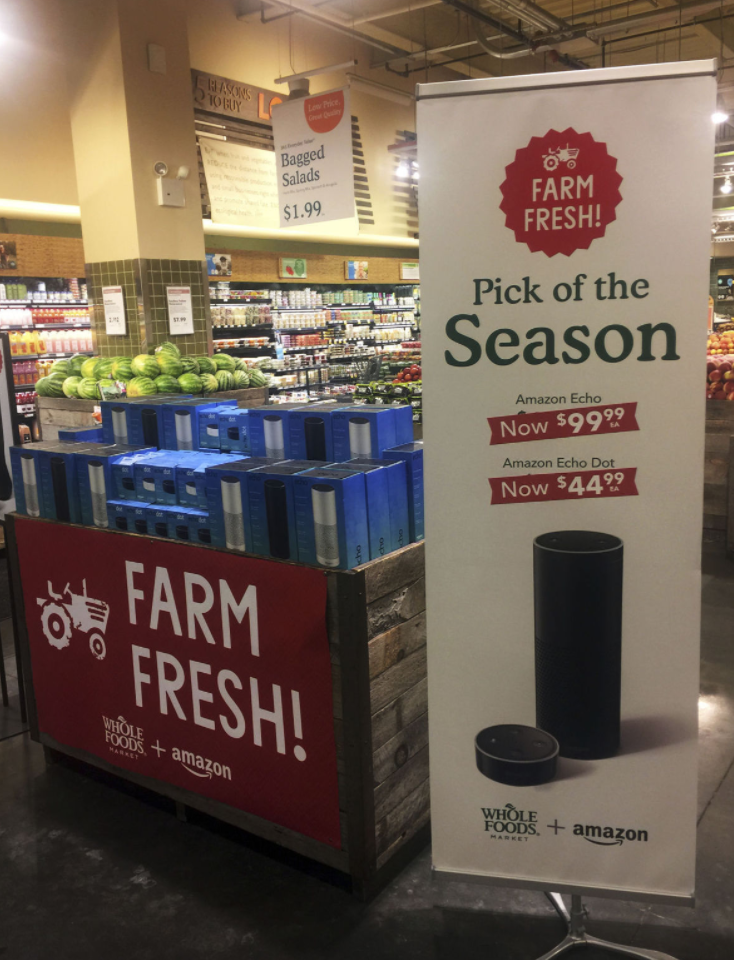
Two months ago, I wrote about the potential impact of the Amazon purchase of Whole Foods on grocery prices. Both here and in the Boston Globe, I hoped and predicted that Amazon would use its famed distribution network to drive down prices on the healthy and organic foodstuffs that made Whole Foods famous.
I’m happy to say that I was right. Today, on Day 1 of Amazon’s official ownership of Whole Foods, Americans got to see the first tangible impacts of Amazon ownership and, as predicted, it was lower prices. As noted by journalists, the chain once derided as Whole Paycheck should now be referred to as “3/4 Paycheck” given deep discounts averaging 25% on a wide range of products ranging from bananas to butter.
Though terrifying for Amazon’s competitors such as Kroger, Walmart and Costco, Amazon’s major foray into brick-and-mortar groceries may end up being a boon for consumers – at least in the short term. It’s no secret that Amazon retains its web startup mentality in aggressively promoting loss leaders to drive out competition. And increased competition will better serve consumers who have been squeezed by recovering inflation on food prices.
Soon, Amazon intends to install more of its Amazon lockers into Whole Foods locations, thereby facilitating deliveries for goods bought on the Amazon website while also increasing foot traffic to its stores. Analysts also speculate that Amazon’s grocery delivery service, Amazon Fresh, may get a much-needed shot in the arm with goods from Whole Foods. The corporate synergy of this deal is palpable – and just beginning.
This makes people nervous. Already, journalists and think tanks have sounded alarms about how Amazon’s growing power may make it a monopoly. They argue that Amazon is an antitrust problem given that it already captures nearly half of U.S. online sales, is the leader in providing cloud computing through Amazon Web Services and has a robust marketing and logistics division.
To bolster their point, it is true that Americans can now spend a large part of their day using Amazon services without even knowing it. You could wake up on a Saturday, go to Whole Foods for groceries, order supplies off Amazon, read a book with your Kindle, watch TV on Netflix (powered by Amazon Web Services) or catch a movie on Amazon Prime Video. All of your needs met by Jeff Bezos and company.
It is understandable that this makes people uneasy. While America has faced more pervasive monopolies, Amazon’s reach is more insidious given that it reaches, and controls, much of our daily lives.
But when it comes to food, does any of this matter? I would argue, no.
A key responsibility of any government or society is provide a secure food supply to everyone. And in this regard, America has failed miserably. As noted in my previous piece, 2.3 million Americans live in extreme food deserts – areas more than one mile from their nearest supermarket and with no access to a vehicle. And even where food deserts do not exist, eating healthy has progressively become more expensive than eating junk food.
Much of this increase in healthy food prices can be attributed to the increasingly niche treatment of fresh food. Tack the label of “superfood” on a product and the price seems to mysteriously skyrocket. A key example is kale, a food blogger favorite, where heightened demand has led to annual price increases of more than 30%.
With Amazon’s purchase of Whole Foods driving prices on fresh foods down in-store, and perhaps online, we might be on the verge of the democratization of fresh and healthy foods. And that’s a good thing.
It’s time to stop treating healthy eating as a choice. The truth is that healthy eating has gotten too expensive and too difficult for those in lower income brackets. And to blame lower-income Americans for failing to eat right, when junk food is fast and ridiculously inexpensive, smacks of out-of-touch elitism.
Instead of fearing the monopoly implications of Amazon-owned Whole Foods, the Trump administration should view it as an opportunity for public-private partnership. With grocery prices likely to fall in the near to medium future, the administration should be looking to expand the scope of SNAP (formerly known as food stamps) into direct food delivery so that low-income families can get fresh foods delivered directly to their homes.
Such programs are not new but they previously faced three major problems: (1) technological, (2) marketing and (3) cost.
Luckily, the technological hurdles to using SNAP online seems to finally have been dealt with. But the other two questions of marketing and cost remained in the pre-Amazon Whole Foods world. However, with Amazon’s new pricing and renewed commitment to the food business and marketing prowess, such a program could finally take off and deal with the issue of food deserts once and for all.
Instead of relying on Amazon or its competitors to figure out the online SNAP model, government should coordinate the process and streamline the required elements in a general Request for Proposals, including pricing controls. Doing so should alleviate concerns about the government enabling the creation of an Amazon monopoly while ensuring that lower-income Americans can get healthy food at reasonable prices.
If, at the end, only Amazon can comply with the RFP then so be it. More Americans desperately need healthy food, whatever the source.
Jason Chung is currently the senior researcher and attorney at NYU Sports and Society, in New York. He tweets at @ChungSports.
